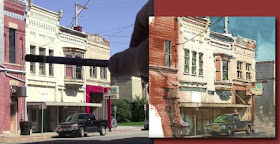Patrick Room from Vienna asks:

"When you go outside to do a sketch, how do you scale down the view so that it fits into your sketchbook? Do you establish an anchor point and connect all the measurements to this point, or do you place your sketchbook far enough away and then measure the subject with your outstretched arm?"
Patrick, that's a good question. Ideally I set up my easel so that the view is sight-size, and I place the easel as close as possible to my line of sight. On a few occasions I have experimented with a sight-size grid viewer to assist with very complex subjects.
But frequently the subject is too far away for sight-size to be possible. In that case I use comparative measurements. I establish a unit of measurement in my view of the subject using a pencil held at arm's length. Then I look for other examples where that unit appears.
You can see this approach in action in my YouTube video "Street Painting in Indiana."

"Street Painting in Indiana", yes, good video!
ReplyDeletethank you so much for answering the question.
ReplyDeleteBut even when you work with comparative measurements you have to start somewhere.
so the first thing is always the eye Level line?
and with the comparative measurements technique the hight/size of the overall finished painting is somehow controlled by the distance you are sitting from the object? so the finished size of the painting in your sketchbook depends also of the place you are sitting?
best regards
I find working with comparative measurements works for me too. I always start with the eye level. Then, if it's a building I'm drawing, I'll use a door or window as my standard measurement. It's then just a case of finding out how many door/window widths wide, the building is, and transfer this to the paper.
ReplyDeleteI find it's the easiest way of making sure the building will fit on the page without running out of space or looking too small in the picture space.
Patrick, usually my first lines are a rough placement of the biggest shapes on the page to see if I like the cropping and the design. Then I check that initial statement with perspective and measurements.
ReplyDeleteGurney, I have been following your art for a little bit now, been drawing a lot myself and thinking about studying illustration. Anyways, I wanted to ask you. How should I start out if I want to draw in a very realistic way, much like you? I read that you as a child taught yourself to draw through books about Howard Pyle and Norman Rockwell. I am wondering what you did to learn what you did and what do you recommend me doing? I've read in books and on the internet, that copying drawings of people you like is a good way of getting good?
ReplyDeleteAmazing art by the way, I think the painting you do outside is incredible and I have never seen someone as good as you.
Thanks for the compliments, Marco. Yes, I would say the best way to learn realistic illustration is a combination of study from observation, along with copies from masters. The process I use is described in my videos and my book Imaginative Realism.
ReplyDeleteThanks for the video. Could you give some details on making your plexiglass grid and straightedge tool?
ReplyDeletethanks so much James. you helped me a ton!! realy appreciate it
ReplyDelete